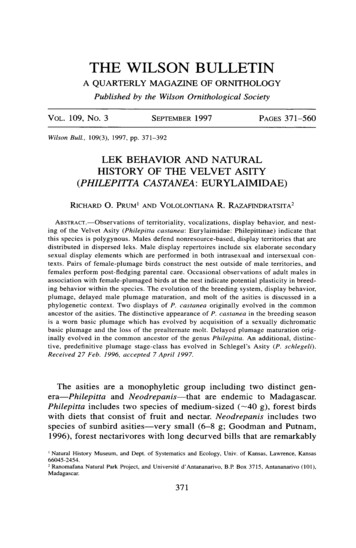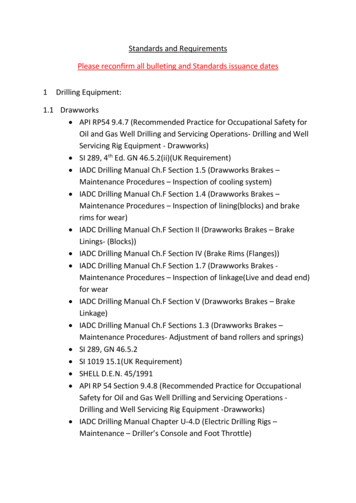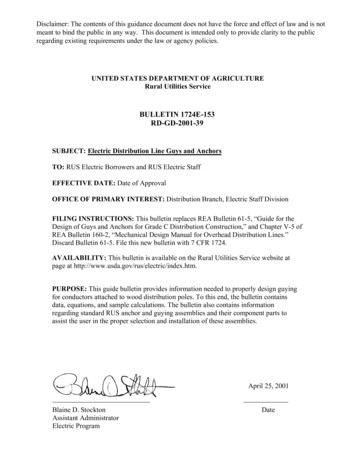
Transcription
THE WILSONA QUARTERLYBULLETINMAGAZINEOF ORNITHOLOGYPublished by the Wilson OrnithologicalVOL. 109, No. 3Wilson Bull.,SEPTEMBER 1997SocietyPAGES 37 l-560109(3), 1997, pp. 371-392LEK BEHAVIOR AND NATURALHISTORY OF THE VELVET ASITY(PHILEPInACASTANEA: EURYLAIMIDAE)RICHARD 0. PRUM’ AND VOLOLONTIANA R. RAZAFINDRATSITA ABSTRACT.-Observationsof territoriality, vocalizations, display behavior, and nesting of the Velvet Asity (Philepitta castanea: Eurylaimidae: Philepittinae) indicate thatthis species is polygynous. Males defend nonresource-based, display territories that aredistributed in dispersed leks. Male display repertoires include six elaborate secondarysexual display elements which are performed in both intrasexual and intersexual contexts. Pairs of female-plumage birds construct the nest outside of male territories, andfemales perform post-fledging parental care. Occasional observations of adult males inassociation with female-plumaged birds at the nest indicate potential plasticity in breeding behavior within the species. The evolution of the breeding system, display behavior,plumage, delayed male plumage maturation, and molt of the asities is discussed in aphylogenetic context. Two displays of P. castanea originally evolved in the commonancestor of the asities. The distinctive appearance of P. castanea in the breeding seasonis a worn basic plumage which has evolved by acquisition of a sexually dichromaticbasic plumage and the loss of the prealternate molt. Delayed plumage maturation originally evolved in the common ancestor of the genus Philepitta.An additional, distinc-tive, predefinitive plumage stage-classhas evolved in Schlegel’s Asity (P.Received27 Feb.1996,accepted7 Aprilschlegeli).1997.The asities are a monophyletic group including two distinct genera-Philepittaand Neodrepanis-thatare endemic to Madagascar.Philepitta includes two species of medium-sized (-40 g), forest birdswith diets that consist of fruit and nectar. Neodrepanis includes twospecies of sunbird asities-verysmall (6-8 g; Goodman and Putnam,1996), forest nectarivores with long decurved bills that are remarkably’ Natural History Museum, and Dept. of Systematicsand Ecology, Univ. of Kansas, Lawrence, Kansas66045.2454.* Ranomafana Natural Park Project, and Universit& d’Antananarivo, B.P. Box 3715, Antananarivo (101).Madagascar.371
Frontispiece.The Velvet Asity (Philepirtu castanea). Alternate, definitive plumage male(upper left) performing the Hanging Gape Display; basic definitive plumage male (middle right);and female (lower left). Inflorescence in upper right is Bakerella cluvatu (Loranthaceae).
372THE WILSONBULLETINlVol. IO9, No. 3, September 1997convergent with many sunbirds (Nectariniidae),hummingbirds (Trochilidae), and Hawaiian honeycreepers (Drepanidae).Traditionallytreated as a separate, isolated family of suboscines (Amadon 195 1,1979; Raikow 1987), asities have long been recognized as a strikingexample of adaptive radiation (Salomonsen 1965). Recent phylogeneticanalysis of the group has documented that the asities are a Malagasylineage of the Old World tropical broadbills (Eurylaimidae;Prum1993). In the phylogenetic context of the broadbills, the adaptive radiation of the asities is even more extreme given that Neodrepanisspecies could be appropriately called “sunbird-broadbills.”The Velvet Asity (Philepitta castanea) is an understory forest frugivorethat is distributed throughout the rain forests of eastern and northern Madagascar (Langrand 1990). Recent field studies have documented that thediet of Velvet Asity is composed of a wide variety of fruit species andnectar from various plants (Goodman and Putnam, 1996; V. R. Razafindratsita and S. Zack, unpubl. data). Most other aspects of the naturalhistory of P. castuneu remain poorly known.P. castanea shares a number of striking ecological and morphological similarities with several groups of well known, polygynous tropical passerines. Like many manakins (Pipridae), cotingas (Cotingidae),birds of paradise (Paradisaeidae), and bowerbirds (Ptilonorhynchidae),P. castanea is primarily frugivorous, is highly sexually dimorphic inplumage, has elaborate secondary sexual characters (e.g., brightly colored, fleshy car-uncles), and delayed male plumage maturation. Thepresence of this unusual and distinctive combination of characters firstlead us to investigate the nature of the breeding system of this species.Our observations indicate that Philepittacastanea,like many otherspecies of frugivorous tropical passerines, is polygynous and breeds ina dispersed lek system. These preliminary observations document thatthe behavioral diversity of the Old World suboscines is even broaderthan currently realized.STUDY AREA AND METHODSThe observations were made in an area of secondary humid tropical forest in RanomafanaNational Park, Ranomafana, Ifanadiana, Madagascar (21”16’S 47”28’E). The study site included a roughly 10 km2 area near the park entrance. Specific localities of territories andnests found in the study area are referred to here by the trail name and the meter numbernearest the site (e.g., A-l lOO-meter1100 of trail A).Initial observations of territorial males were made during the 1993-94 breeding seasonby V R. Razafindratsita between 24 Nov.-15 Dec. 1993 and 23 Jan.-l Feb. 1994, and byR. 0. Prum on 22-25 January 1994. The second field season was from 2-29 November1994. Twenty-four Velvet Asities were banded with distinct color combinations in the studyarea between 1991-1993 by S. Zack and colleagues. An additional seven individuals were
Prum and Raza ndratsiralVELVETASITYBEHAVIOR373banded by the authors in November 1994. Three of these latter birds were subsequentlyobserved as territorial males.All observations were made with binoculars and without blinds between 5 and 20 m fromthe birds. Tape recordings of vocalizations were made using a Sony TCM-5000with aSennheiser ME-80 microphone. Spectrograms were prepared using Canary 1.2 (Charif et al.1995). Video tape recordings of Velvet Asities were made using a Canon L2 high-8 mmcamera. Data for ethograms of focal territorial males was taken using 5min observationperiods. During each 5-min observation period, we recorded whether the male was presentin, exited, or entered the territory; the position and height of its perch; changes in perch;vocalizations or displays; intraspecific and interspecific interactions; foraging events; regurgitation; and preening. A total of 40 h of observations of eight territorial males was completed.Information on plumage and morphology was gathered from observation of museum skinsin the collections of the American Museum of Natural History (AMNH), New York, theField Museum of Natural History (FMNH), Chicago, and the Museum National d’HistoireNaturelle (PM), Paris.RESULTSPlumage and morphology.-Theplumage of female P. castanea isdull green above with wide green and gray longitudinal stripes below(see Frontispiece). The legs are grey, the bill black, and the iris darkbrown. The definitive plumage of adult male P. castanea changes seasonally. Adult males go through a complete prebasic body molt sometime between February and May (earliest in northern Madagascar). Thefresh, definitive basic plumage male (or adult nonbreeding aspect) isblack on the face, throat, and flight feathers, and black with olive greenfeather edgings over the rest of the body (See Frontispiece). The greenfeather edgings wear off and ultimately produce a distinctive, blackappearance during the breeding season (which is refered to here as thebreeding aspect of the definitive basic plumage). The definitive malebreeding aspect is velvety black with a bright yellow spot on the uppermarginal alular wing coverts (See Frontispiece). These yellow “wrist”feathers are usually concealed when an adult male is perched. Thereis no prealternate molt. Thus, the definitive male breeding aspect is aworn basic plumage, not a distinct plumage produced by a distinctmolt. During the transitional period from nonbreeding to breeding aspect, males are individually identifiable by the distinctive patterns ofwear of the green feather edgings. Little is known about the molt offemales, predefinitive males, or flight feather molt in either sex. Thereis no sexual dimorphism in size (Goodman and Andrianarimisa 1995).Definitive breeding aspect males also have a pair of brilliant fleshysupraorbital caruncles (Prum et al. 1994). The caruncle is mostlybright, vivid green with a central horizontal sky blue stripe above theeye. At rest, the caruncle is a flaccid and wrinkled flap of unfeathered
374THEWILSONBULLETINlVol. 109, No. 3, September 1997skin above the eye (Fig. 5). The rostra1 portion of the cat-uncle is aflat, rounded lobe that lies over the culmen. The caudal portion of thecaruncle is a narrow, wrinkled strip that lies above the eye and curvesventrally below and behind the eye. The horizontal blue stripe is concealed within a prominent horizontal wrinkle or fold in the center ofthe caruncle above the eye. The caruncle is covered with tiny coneshaped, keratinized papillae that include macrofibrils of collagen thatproduce the structural color (Prum et al. 1994). At rest, the carunclesvary in size and shape within and among males. Some males are individually distinguishable by particular features of their caruncles, particularly the wrinkled dorsal margin and the extent of curvature belowand behind the eye. Males can immediately erect the caruncles intotwo straight planes above the eyes (Fig. 2). When the caruncle is erect,the rostra1 and caudal portions of the caruncle straighten, and extendupward, exposing the bright blue central stripe. The erection of thecaruncles is a prominent feature of the erect posture and wing-flapdisplay performed by territorial males (see below). The shape and position of the caruncles are under immediate muscular control. Videotape recordings of males document that they can move the caruncleinstantaneously. Histological sections of the caruncle also show prominent striated muscle tissue in the caruncle that presumably controls itsshape (Prum et al. 1994: fig. 2, lower left).The caruncles of males are absent in nonbreeding, basic plumage males.They apparently develop annually before the breeding season (betweenJune and November, depending on latitude). Nothing is known about themechanism of development of the caruncles.Predefinitive males have enlarged gonads, essentially female-like plumage and lack developed caruncles (Rand 1936; Benson 1976:367-369; S.M. Goodman, pers. comm.). At least some, and perhaps all, predefinitivemales can be distinguished from females in the hand by a whitish, featherless patch of skin above the eyes, which is the precursor of the definitivecaruncle of adult males (Prum et al. 1994; R. 0. Prum, pers. obs.; FMNH345697). Predefinitive males also vocalize and perform rudimentary displays (see below). Nothing is known about the amount of time male P.castanea spend in predefinitive plumage before they acquire definitivemale plumage and cat-uncles.Male territoriality.-Observationswere made of eight territorial, adultmale castanea in two subsequent breeding seasons (Table 1). Male territories are approximately lo-20 m in diameter. Most territories identifiedwere adjacent to another male territory, with territory centers less than50 m apart (ER-0 and ER-35; A-l 100 and A-l 110; n-25, n-75, andrr-125). In all of these cases, males in adjacent territories were within
Prum and Raza ndratsitalVELVETTABLETERRITORIALA ENDENCEBY MALERANONOMAFANAASITYPARK,(PHILEPITTA #l-GRWWaA-l LASITY1994-1995DCCJanFeb*************NW***** Territorial, adult male was cited at this locality dunng that montha Banded during November 1994.auditory range of one another. Only a single male (GWOO, E-10) wasout of immediate hearing range of other known territorial males; he was125 m from the closest other male. Three males banded in early November 1994 were subsequently observed defending territories later thatmonth. Two of these three males occupied the same territories and usedthe same vocalization perches as unbanded males in January 1994, duringthe previous breeding season. An unbanded male (UB#3) was also observed in the same territory in two consecutive breeding seasons. Thismale was individually identifiable by plumage and caruncle shape duringten observation days in late November 1994. Males were not observeddefending territories until they had completed a majority of the transitionfrom the nonbreeding basic asect to the worn, breeding aspect of the basicplumage (i.e. were mostly black). Additional observations are required toconfirm this conclusion. Predefinitive males were not observed defendingterritories.Males advertise and defend territories by perching on a horizontalbranch or liana between l-5 m above the ground (x 2.5 m, N 218)and calling (see below). Males were observed using more than 20 different vocalization perches within a territory, but a few specific perches wereusually preferred. Male territorial attendance varied with season. FromDecember 1993 through early February 1994, males were present on territory for 63-92% of 5-minute observation periods between 05:30 and16:O0. In early November 1994, males were not territorial. Between20-29 November 1994, apparently at the beginning of this breeding season, males were present on territory between 40-70% of 5-minute periods
376THE WILSONBULLETINlVol. 109, No. 3, September 1997213SecondsFIG. 1. Spectrograms of vocalizations of the Velvet Asity Philepittu cas unea at Ranomafana National Park, Madagascar. (A) The advertisement call (weee-dooo); and (B) theweet .).long call (weefbetween 05:30 and 8:30. Later in the day, territorial attendance droppedoff completely.Males frequently left their territories for short periods to forage orinteract with other birds (N 99; 28% of observation periods with malein attendance). Limited food resources were located within male territoriesand males occasionally did forage within their territories, but males mostfrequently left the territory to forage elsewhere.At Ranomafana, female castunea build nests exclusively in a singlespecies of tree (Tumbourissu obevatu, Monimiaceae; see Nesting below).Five male territories that were carefully surveyed did not include a singleindividual of this common tree species (A-l 100, A-l 110, ER-0, E-10,r-25).Vocalizations and mechanical sounds.-Malesgive a high, thin,squeaky advertisement vocalization that is a pair or short series ofweee-dooo notes, with a conspicuous emphasis on the first syllable. Eachweee-dooo phrase is characterized by an initial note that rises from -5.5to 6.3 kHz over 100 ms, a 50 ms pause, and a final note that descendsfrom -5.4 to 4.8 kHz over 150 to 190 ms (Fig. 1A). This vocalizationis inconspicuous, low in amplitude, and can be difficult to detect at morethan 20 m away.During male-male interactions (see below), males give a long call,which is an energetic, nearly continuous series of call notes similar to theinitial syllable of the advertisement call-weet . . . weet . . . weet . . . weet.Each weet note rises -1-3 kHz over 80 ms from between 5.5-6.3 kHzto 7.4-8.2 kHz, and are separated from one another by 0.75 to 1.5 s (Fig.1B). Series of long calls can be given continuously for minutes.A third rare vocalization, a high thin seeeeee call, was heard on several
Prum and Raza ndratsita VELVETlTABLEFREQUENCYOF VOCALIZATIONANDDISPLAYCASTANEA)IN RANONOMAFANAASITY377BEHAVIOR2ELEMENTSNATIONALBY y overall observauon periods’Territorial Attendance33.565%cAdvertisement CallLong Call BoutsWing Flap PumpOpen-Gape DisplayHanging Gape DisplayPerch-Somersault y wthmale in attendance016.71.232.500.500.170.62*Mean observations per hour over all 542 5.min. observation periods.h Mean observations per hour over the 355 5-m& observation periods with the male in attendance.‘ % of the 542 5.min. observation periods with male m attendance.instances during interactions between territorial males. This vocalizationwas not recorded.Presumed predefinitive males with female-like plumage were observedand recorded giving both the advertisement and long calls during visitsto established territories and while following foraging females.Adult males produce a notable whirring sound during flight that ispresumably produced by the wings. This sound was heard during bothdisplay and foraging, and did not appear to be modulated or controlledby the male. Female-plumage birds were not observed making this wingnoise, but this may be a result of limited observations at close distances.It is not known whether this wing sound serves as a sexually dimorphicacoustic advertisement, or whether their is sexual dimorphism in the shapeof the remiges.Territorial male castultea vocalize relatively infrequently (Table 2). Theweee-dooo advertisement call was given an average of 10.9 times perobservation hour (16.7 times per hour during the five-minute observationperiods when the male was on territory). Long call bouts were observed36 times at an average frequency of 0.8 bouts per observation hour. Vocalactivity is greatest in the morning between 06:OO and lO:OO, but precisemeasures of daily temporal variation are skewed by the greater numberof morning observation periods.Display elements.-Sixcomplex male display elements were observed:(1) the erect posture, (2) the wing-flap pump display, (3) the horizontalposture, (4) the open gape display, (5) the hanging gape display, and (6)the perch-somersault display.In the erect posture, the male assumes an erect, “rooster-like”pos-
378THE WILSONFIG. 2.BULLETIN- Vol. 109, No. 3, September 1997The erect posture of the Velvet Asity Philepitta castanea.ture with its neck and body elongated and leaning forward over theperch, and erecting the brilliant green and blue caruncles (Fig. 2).When erect, the caruncles are raised into two planes running from thebase of the beak to above and behind the eye, resembling two sides ofa tricornered hat, and exposing the light blue horizontal stripe abovethe eye. The erect posture is strikingly different from the typical inert,pear-shaped appearance of perched P. castanea when perched. (Anaccurate account of the frequency of the erect posture was not recordedbecause this display was not identified as a distinct element until latein the observations).Performances by two different males of the wing-flap pump displaywere observed well. One male maintained the erect posture for l-2 s,and suddenly leaned forward and horizontal over the perch. The malethen briefly pumped up and forward, pointing its beak, fully extendingits neck, raising up on its long tarsi, and returning back to erect postureon the perch. Then after a short pause, the male performed a secondvertical pump and opened and closed both its wings simultaneously
Prum and Razajindratsita VELVETlFIG. 3.ASITYBEHAVIOR379The wing-flap pump display of the Velvet Asity Phikpittu castanea.(Fig. 3). At this moment, the body is at its most erect position, and thebroad black wings were held open vertically at the sides and parallelto the body (Fig. 3). The yellow alular covert wing spots were alsoprominently flashed against this dark, bat-like profile. In a single videotape recording of this male displaying, the first and second pumps were0.23 and 0.26 s long, respectively, with a single 0.1 s pause in betweenthem. In the wing-flap pump display of a second male, the two pumping movements were immediately followed by a series of two to fiveasynchronous, single wing flaps that were performed without pumpingmovements. The order in which each wing was flapped appeared random. Each male always performed the display in the same fashion. Thedisplay is performed silently. A total of seventy-five performances ofthe wing-flap pump by five different males were observed, for a frequency of 1.70 displays per observation hour (Table 2). Males wereobserved assuming the erect posture without proceeding to the wingflap or pumping movements.In the horizontal posture, the male assumes a sleek horizontal positionon the perch with the neck elongated (Fig. 4). Typically, the horizontalposture is assumed after a male has heard the call of another neighboringmale. The male then peers intently for a brief period and then flicks hiswings once or twice before leaving the perch. (An accurate account of
380THE WILSONFIG. 4.BULLETINlVol. 109, No. 3, September1997The horizontal posture of the Velvet Asity Philepittu custunea.the frequency for the horizontal posture was not recorded because thisdisplay element was not identified until late in the observations).In the open gape display (N 15), a male perches with its head pulledin, and its mouth open wide held up at a slight angle, prominently exposing the bright yellow gape (Fig. 5). While perched in this posture, themale may open its mouth silently or give an extended and energetic seriesof long calls. Frequently, the male flies from perch to perch, giving con-FIG. 5.The open gape display of the Velvet Asity Philepitta castanea.
Prum and Razajindratsita - VELVETFIG. 6.ASITYBEHAVIOR381The hanging gape display of the Velvet Asity Philepitta castanea.tinuous long calls, and assuming the open gape posture on each perch.The caruncles are not raised during the open gape display. The open gapedisplay was infrequently observed (Table 2).On several occasions (N 5), males performed a fifth elaboratedisplay movement. In the hanging gape display, a male in the gapeposture suddenly throws itself forward and downward with an awkward flap of the wings and hangs from the perch (Fig. 6). The hangingmale faces forward with its head held horizontal, its wings closed, itstail nearly vertical and above the perch, and its gape open. After 0.5to several seconds, the male flies from the perch. Sometimes, the malecontinues giving long calls throughout the display. The sudden initiation of the hanging gape display looks as if the male were about to flyfrom the perch but accidentally tripped over its long toes while leaving.A distinct perch-somersault display was observed twice (N 2) beingperformed by two different males. During this display, the male appearedto initiate a hanging gape display, but instead of hanging, it completelyrotated around the perch to resume a normal open gape display posture.Presumed predefinitive males in female-like plumage were observedperforming the erect posture, the wing-flap pump display, and the opengape display.Zntruspeci c interactions.-Territorialmales frequently interact with
382THEWILSONBULLETINlVol. 109, No. 3, September 1997other individuals including adult males, and presumed predefinitive malesand females. Interactions among adult males usually began as bouts ofcountersinging between territorial neighbors (N 29). After a few callseach, countersinging males frequently left their perches, and approachedeach other along their mutual territorial boundaries. Neighboring adultmales were never observed intruding directly on a male’s territory. Interactions with predefinitive males (N 7) were similar but predefinitivesoccasionally enter a male’s territory directly. Predefinitive males wereidentified by their female-like plumage, advertisement vocalizations, postures or displays, and frequent aggressive perch changes.The open gape and hanging bow displays were most frequently performed during competitive male-male interactions. Two males commonlyperch 5 m apart at the boundary of their territories, vocalized energetically, chased one another, and performed repeated open gape displaysand occasional hanging gape displays.On most occasions, the erect posture and the wing-flap pump displaywere performed in response to a second, unobserved bird. On five occasions, visits to male territories by presumed females were observed.These female-plumage individuals did not call, posture, or act aggressively toward the resident males, as did presumed predefinitive males.After excited advertisement calling, territorial males became silent andperformed the erect posture and wing-flap pump displays repeatedly untilthe female exited the territory. Interactions between territorial males andpresumed females were frequently disrupted by the distracting activity ofneighboring males. On several occasions, two adult males pursued a presumed female off their territories with repeated calls and displays. Nocopulations were observed.In general, the horizontal, open gape, and hanging gape displays appearto serve an intrasexual, competitive function, whereas the erect postureand the wing-flap pump display serve an intersexual function. On someoccasions males performed the erect posture or the wing-flap pump display during interactions with other males, but in several of these cases itappeared that another unseen individual, perhaps female, was present.Znterspecijic interactions.-Territorialmale Velvet Asity occasionallyresponded to intrusions of other species on the territory. Several times,wing-flap pump displays were performed by males in response to a birdof another species-e.g., Blue Coua (Coua caerulea), Madagascar PygmyKingfisher (Zspidinu muduguscuriensis), and Wedge-tailed Jery (Hurtertulu Jlavoviridis). On two occasions, a territorial male performed thewing-flap pump in response to our arrival at its territory early in themorning.Preening.-Territorialmales preen their plumage with their bills and
Prum and Razafindratsita - VELVETASITYBEHAVIOR383feet persistently throughout the day. Preening was observed in 128 5-minobservation periods (23% of observation periods, or 36% of observationperiods in which the male was present on his territory). Preening behaviorwas often extensive. For example, on one occasion a male was observedpreening continuously on a single perch for over 25 min. In another instance, a male seized a 1 cm-long ant and rubbed it in on body plumagefor about 10 sec. No other unusual movements were associated with this“anting” behavior.Nesting and fledgling cure.-Allof the more than 25 nests of P. castunea that have been observed at Ranomafana over the last decade wereplaced near the end of long overhanging branches of a single commonspecies of forest tree: Tumbourissa obevatu (Loret Rasabo, pers. comm.;Prum and Razafindratsita, in prep). Tumbourissa obevatu has simple, entire leaves about 15 cm long with pointed “drip tips.” Nest trees arefrequently reused over a number of years. In November 1994, a singlelarge tree at Ranomafana included remnants of six castunea nests thathad been constructed on different branches in previous seasons.The nest of P. castunea is a hanging sphere of moss and fine plantfibers about 25 cm long and 12 cm wide. Nest construction and fledglingattendance were observed on several occasions by Razafindratsita in the1993-1994 breeding season. Three partial or complete nests were observed in late November and December 1993 (C-125, C-275, and F-O).Construction was observed at the C-125 and C-275 nests. Each nest wasbuilt by two female-plumaged birds that were closely associated with oneanother and frequently perched within one m of each other near the nest.One of the pair of individuals at the C-125 nest in 1993 was certainlyfemale since it was banded in female plumage in 1991. Nests were builtover more than ten days. One nest that was nearing completion on 27November 1993 had no eggs inside on 8 December 1993. No nests werefound in November 1994.Nests were not placed in known male territories, but adult males wereobserved in the vicinity of two nests. One male was observed exitingfrom the C-125 nest on 26 November 1993, and associating briefly withthe two female-plumaged birds. An adult male was also observed in association with two female-plumaged birds near the C-275 nest on oneoccasion. This male called and chased the two female plumage birds.These males, however, were not consistently associated with these nests,and were not observed constructing the nests.A single female-plumaged bird was observed attending a group of threedependent fledglings for one hour by Razafindratsita on 26 January 1994at C-300, just 25 m from one nest observed in the previous month. Thefledglings had female-like plumage but were distinguished by having few-
384THEWILSONBULLETIN- Vol. 109, No. 3, September1997er stripes below, shorter tails, and conspicuous yellow gape marks. Thethree fledglings begged and chased the presumed female. The femaleplumaged bird foraged for fruits and placed them whole in the mouthsof the begging young.Diet.-Thediet and ecology of P. castunea is being studied intensivelyat Ranomafana by V. R. Razafindratsita and S. Zack (in prep.). Theirobservations confirm that castuneu is extensively frugivorous. However,our observations during November 1994, when the weather was unusuallydry and fruit was extremely scarce, indicate that nectar feeding is a seasonally important food source for custuneu. Of particular importance isBakerella-acommon parasitic mistletoe (Loranthaceae) with abundant,bright pink flowers (See Frontispiece). Male UB#3 was observed foragingon the Bakerella nectar on 12 occasions during ten observation days inlate November 1994.Salomonsen (1965) states that the tongue of custuneu is unspecializedfor nectar feeding. However, observations of the tongues of spirit specimens show that the tongue of P. custuneu is bifid distally, and that eachside is divided into numerous, fine brushy tips, as found in other nectarivorous birds (FMNH 345696-7, 345708- 10).Annual cycle.-Langrand(1990) states that nesting has been observedfrom August through January, but this includes records from the entirerange of custuneu. At Ranomafana, P. custuneu breeds between November and February. N
Information on plumage and morphology was gathered from observation of museum skins in the collections of the American Museum of Natural History (AMNH), New York, the Field Museum of Natural History (F











